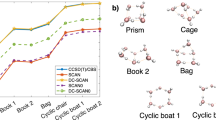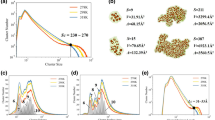Abstract
Proton transfer to and from water is critical to the function of water in many settings. However, it has been challenging to model. Here, we present proof-of-principle for an efficient yet robust model based on Lewis-inspired submolecular particles with interactions that deviate from Coulombic at short distances to take quantum effects into account. This “LEWIS” model provides excellent correspondence with experimental structures for water molecules and water clusters in their neutral, protonated and deprotonated forms; reasonable values for the proton affinities of water and hydroxide; a good value for the strength of the hydrogen bond in the water dimer; the correct order of magnitude for the stretch and bend force constants of water; and the expected time course for Grotthuss transport in water chains.






Similar content being viewed by others
References
Agmon, N.: Proton solvation and proton mobility. Isr. J. Chem. 39, 493 (1999)
Nagle, J.F., Morowitz, H.J.: Molecular mechanisms for proton transport in membranes. Proc. Natl. Acad. Sci. U. S. A. 75, 298 (1978)
Careri, G.: Cooperative charge fluctuations by migrating protons in globular proteins. Prog. Biophys. Mol. Biol. 70, 223 (1998)
Decoursey, T.E.: Voltage-gated proton channels and other proton transfer pathways. Physiol. Rev. 83, 475 (2003)
Stillinger, F.H., David, C.W.: Polarization model for water and its ionic dissociation products. J. Chem. Phys. 69, 1473 (1978)
Halley, J.W., Rustad, J.R., Rahman, A.: A polarizable, dissociating molecular-dynamics model for liquid water. J. Chem. Phys. 98, 4110 (1993)
David, C.W.: A variable charge central force model for water and its ionic dissociation products. J. Chem. Phys. 104, 7255 (1996)
Lussetti, E., Pastore, G., Smargiassi, E.: A fully polarizable and dissociable potential for water. Chem. Phys. Lett. 381, 287 (2003)
Jorgensen, W.L., Chandrasekhar, J., Madura, J.D., Impey, R.W., Klein, M.L.: Comparison of Simple Potential Functions for simulating liquid water. J. Chem. Phys. 79, 926 (1983)
Mahoney, M.W., Jorgensen, W.L.: A five-site model for liquid water and the reproduction of the density anomaly by rigid, nonpolarizable potential functions. J. Chem. Phys. 112, 8910 (2000)
Berendsen, H.J.C., Postma, J.P.M., van Gusteren, W.F., Hermans, J.: Interaction models for water in relation to protein hydration. In: Intermolecular Forces, pp. 331–342. Reidel, Dordrecht (1981)
Berendsen, H.J.C., Grigera, J.R., Straatsma, T.P.: The missing term in effective pair potentials. J. Phys. Chem. 91, 6269 (1987)
Guillot, B.: A reappraisal of what we have learnt during three decades of computer simulations on water. J. Mol. Liq. 101, 219 (2002)
Warshel, A., Weiss, R.M.: An empirical valence bond approach for comparing reactions in solutions and in enzymes. J. Am. Chem. Soc. 102, 6218 (1980)
Cuma, M., Schmitt, U.W., Voth, G.A.: A multi-state empirical valence bond model for acid-base chemistry in aqueous solution. Chem. Phys. 258, 187 (2000)
Dellago, C., Hummer, G.: Kinetics and mechanism of proton transport across membrane nanopores. Phys. Rev. Lett. 97, 245901 (2006)
Xu, J.C., Voth, G.A.: Computer simulation of explicit proton translocation in cytochrome c oxidase: the D-pathway. Proc. Natl. Acad. Sci. U. S. A. 102, 6795 (2005)
Lemberg, H.L., Stillinger, F.H.: Central-force model for liquid water. J. Chem. Phys. 62, 1677 (1975)
Stillinger, F.H., Rahman, A.: Revised central force potentials for water. J. Chem. Phys. 68, 666 (1978)
Weber, T.A., Stillinger, F.H.: Reactive collisions of H3O+ and OH- Studied with the polarization model. J. Phys. Chem. 86, 1314 (1982)
Pomes, R., Roux, B.: Theoretical study of H+ translocation along a model proton wire. J. Phys. Chem. 100, 2519 (1996)
Pomes, R., Roux, B.: Free energy profiles for H+ conduction along hydrogen-bonded chains of water molecules. Biophys. J. 75, 33 (1998)
Lewis, G.N.: The atom and the molecule. J. Am. Chem. Soc. 38, 762 (1916)
Owicki, J.C., Shipman, L.L., Scheraga, H.A.: Structure, energetics, and dynamics of small water clusters. J. Phys. Chem. 79, 1794 (1975)
Snir, J., Nemenoff, R.A., Scheraga, H.A.: Revised empirical potential for conformational, intermolecular, and solvation studies .1. Evaluation of problem and description of model. J. Phys. Chem. 82, 2497 (1978)
Nemenoff, R.A., Snir, J., Scheraga, H.A.: Revised empirical potential for conformational, intermolecular, and solvation studies. 2. Parameterization and testing for water and saturated organic-molecules. J. Phys. Chem. 82, 2504 (1978)
Koide, A.: A new expansion for dispersion forces and its application. J. Phys. B: At. Mol. Phys. 9, 3173 (1976)
Metropolis, N., Ulam, S.: The Monte Carlo method. J. Am. Stat. Assoc. 44, 335 (1949)
Metropolis, N., Rosenbluth, A.W., Rosenbluth, M.N., Teller, A.H., Teller, E.: Equation of state calculations by fast computing machines. J. Chem. Phys. 21, 1087 (1953)
Frenkel, D., Smit, B.: Understanding Molecular Simulation from Algorithms to Applications. Academic Press, San Diego (2002)
Jorgensen, W.L., Tirado-Rives, J.: Molecular modeling of organic and biomolecular systems using BOSS and MCPRO. J. Comput. Chem. 26, 1689 (2005)
Swope, W.C., Andersen, H.C., Berens, P.H., Wilson, K.R.: A computer-simulation method for the calculation of equilibrium-constants for the formation of physical clusters of molecules - application to small water clusters. J. Chem. Phys. 76, 637 (1982)
Jensen, P.: The potential-energy surface for the electronic ground-state of the water molecule determined from experimental-data using a variational approach. J. Mol. Spectrosc. 133, 438 (1989)
Hunter, E.P.L., Lias, S.G.: Evaluated gas phase basicities and proton affinities of molecules: an update. J. Phys. Chem. Ref. Data 27, 413 (1998)
Sears, T.J., Bunker, P.R., Davies, P.B., Johnson, S.A., Spirko, V.: Diode-laser absorption-spectroscopy of D3O+ - determination of the equilibrium structure and potential function of the oxonium ion. J. Chem. Phys. 83, 2676 (1985)
Owrutsky, J.C., Rosenbaum, N.H., Tack, L.M., Saykally, R.J.: The vibration-rotation spectrum of the hydroxide anion (OH-). J. Chem. Phys. 83, 5338 (1985)
Dewar, M.J.S., Dieter, K.M.: Evaluation of Am1 calculated proton affinities and deprotonation enthalpies. J. Am. Chem. Soc. 108, 8075 (1986)
Lide, D.R.: CRC Handbook of Chemistry and Physics, 76th edn. CRC Press, Boca Raton (1995)
Bartmess, J.E., Scott, J.A., Mciver, R.T.: Scale of acidities in the gas-phase from methanol to phenol. J. Am. Chem. Soc. 101, 6046 (1979)
Odutola, J.A., Dyke, T.R.: Partially deuterated water dimers - microwave-spectra and structure. J. Chem. Phys. 72, 5062 (1980)
Fridgen, T.D., McMahon, T.B., MacAleese, L., Lemaire, J., Maitre, P.: Infrared spectrum of the protonated water dimer in the gas phase. J. Phys. Chem., A. 108, 9008 (2004)
Samson, C.C.M., Klopper, W.: Ab initio calculation of proton barrier and binding energy of the (H2O)OH- complex. J. Mol. Struct., THEOCHEM 586, 201 (2002)
Xantheas, S.S.: On the importance of the fragment relaxation energy terms in the estimation of the basis set superposition error correction to the intermolecular interaction energy. J. Chem. Phys. 104, 8821 (1996)
Stern, H.A., Rittner, F., Berne, B.J., Friesner, R.A.: Combined fluctuating charge and polarizable dipole models: application to a five-site water potential function. J. Chem. Phys. 115, 2237 (2001)
Rick, S.W., Stuart, S.J., Berne, B.J.: Dynamical fluctuating charge force-fields - application to liquid water. J. Chem. Phys. 101, 6141 (1994)
Ren, P.Y., Ponder, J.W.: Polarizable atomic multipole water model for molecular mechanics simulation. J. Phys. Chem., B. 107, 5933 (2003)
Curtiss, L.A., Frurip, D.J., and Blander, M.: Studies of molecular association in H2O and D2O vapors by measurement of thermal-conductivity. J. Chem. Phys. 71, 2703 (1979)
Ponder, J.W., Case, D.A.: Force fields for protein simulations. Adv. Protein Chem. 66, 27 (2003)
Headrick, J.M., Bopp, J.C., Johnson, M.A.: Predissociation spectroscopy of the argon-solvated H5O2+ “Zundel” cation in the 1000-1900 cm(-1) region. J. Chem. Phys. 121, 11523 (2004)
Schmitt, U.W., Voth, G.A.: Multistate empirical valence bond model for proton transport in water. J. Phys. Chem., B. 102, 5547 (1998)
Xantheas, S.S.: Ab-Initio studies of cyclic water clusters (H2O)(n), n = 1-6 .3. Comparison of density-functional with MP2 results. J. Chem. Phys. 102, 4505 (1995)
Pedulla, J.M., Kim, K., Jordan, K.D.: Theoretical study of the n-body interaction energies of the ring, cage and prism forms of (H2O)(6). Chem. Phys. Lett. 291, 78 (1998)
Xantheas, S.S., Apra, E.: The binding energies of the D-2d and S-4 water octamer isomers: High-level electronic structure and empirical potential results. J. Chem. Phys. 120, 823 (2004)
Chaudhuri, C., Wang, Y.S., Jiang, J.C., Lee, Y.T., Chang, H.C., Niedner-Schatteburg, G.: Infrared spectra and isomeric structures of hydroxide ion-water clusters OH- (H2O)(1-5): a comparison with H3O+ (H2O)(1-5). Mol. Phys. 99, 1161 (2001)
Sagnella, D.E., Laasonen, K., Klein, M.L.: Ab inito molecular dynamics study of proton transfer in a polyglycine analog of the ion channel Gramicidin A. Biophys. J. 71, 1172 (1996)
Mei, H.S., Tuckerman, M.E., Sagnella, D.E., Klein, M.L.: Quantum nuclear ab initio molecular dynamics study of water wires. J. Phys. Chem., B. 102, 10446 (1998)
Brewer, M.L., Schmitt, U.W., Voth, G.A.: The formation and dynamics of proton wires in channel environments. Biophys. J. 80, 1691 (2001)
von Grotthuss, C.J.D.: Sur la decomposition de l’eau et des corps qu’elle tient en dissolution a l’aide de l’electricite galvanique. Ann. Chim. LVIII, 54 (1806)
Agmon, N.: The grotthuss mechanism. Chem. Phys. Lett. 244, 456 (1995)
Acknowledgements
We thank Peter Jordan and Michael Francis Hagan for helpful discussions, Liliya Vugmeyster for guidance in Monte Carlo simulation, and Ercan Kamber for his advice regarding high performance computation. This work was supported by NIH grant R01EB001035.
Author information
Authors and Affiliations
Corresponding author
Rights and permissions
About this article
Cite this article
Kale, S., Herzfeld, J., Dai, S. et al. Lewis-inspired representation of dissociable water in clusters and Grotthuss chains. J Biol Phys 38, 49–59 (2012). https://doi.org/10.1007/s10867-011-9229-5
Received:
Accepted:
Published:
Issue Date:
DOI: https://doi.org/10.1007/s10867-011-9229-5




